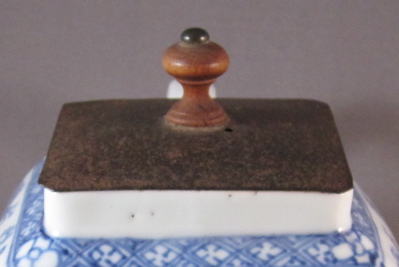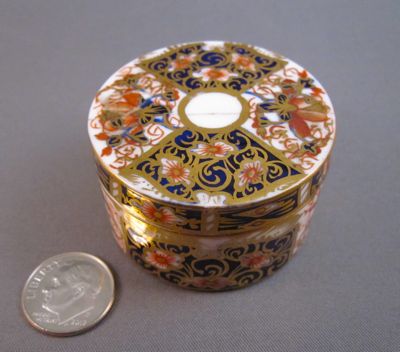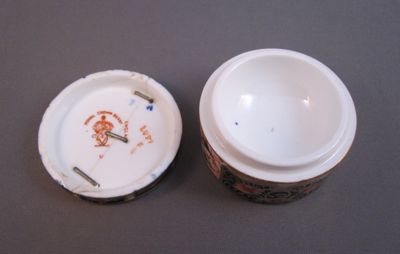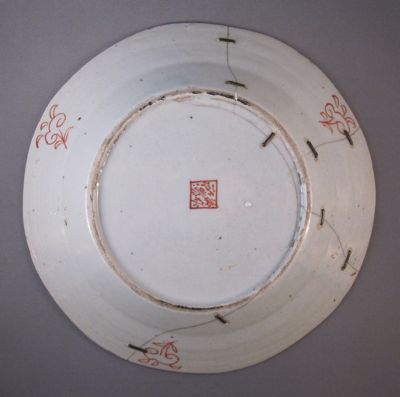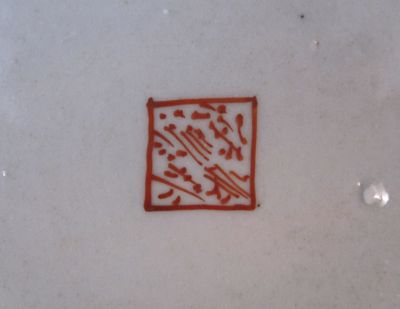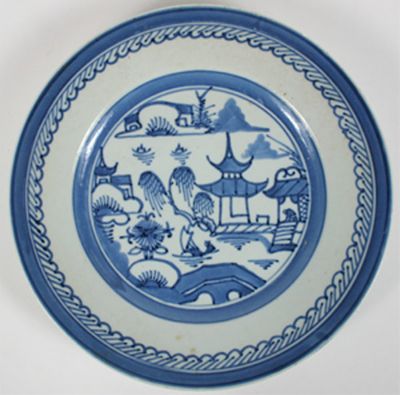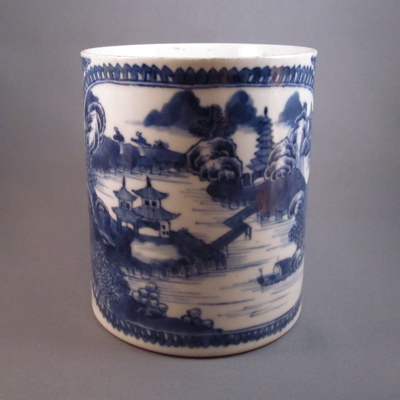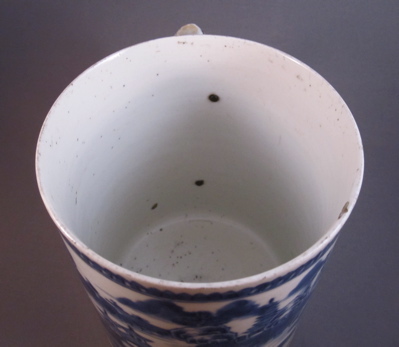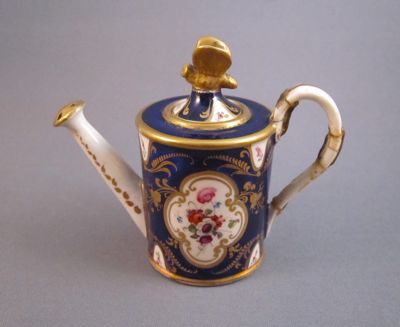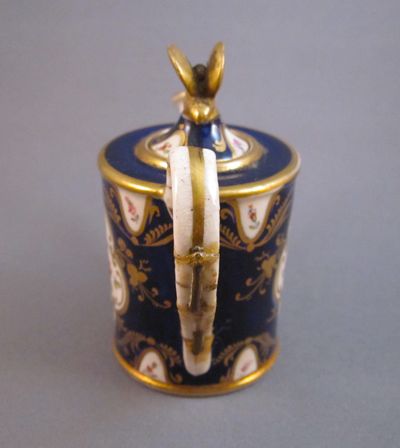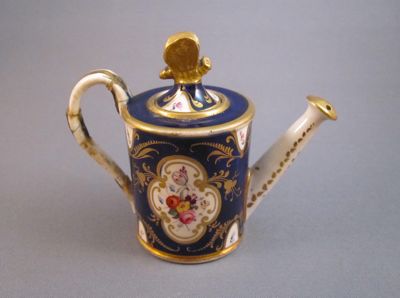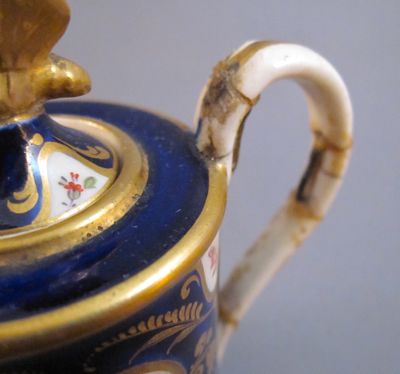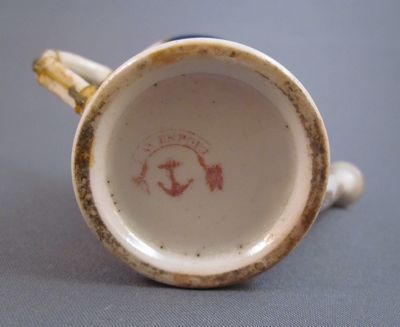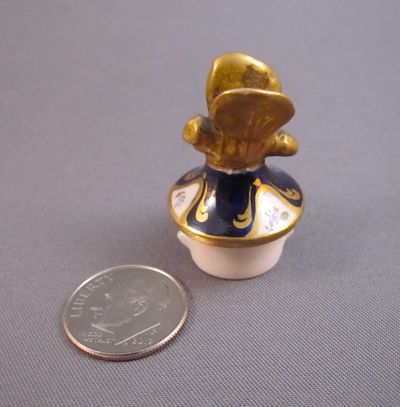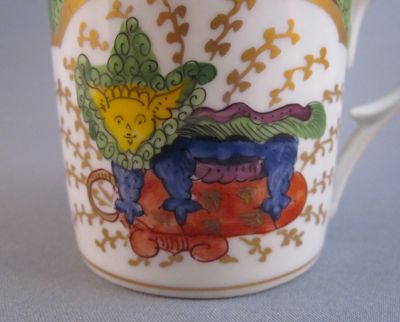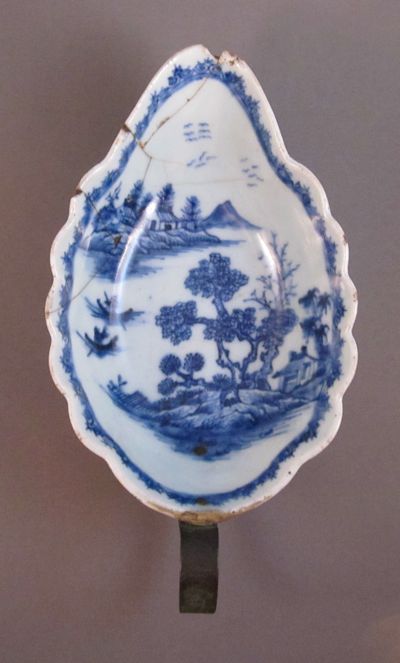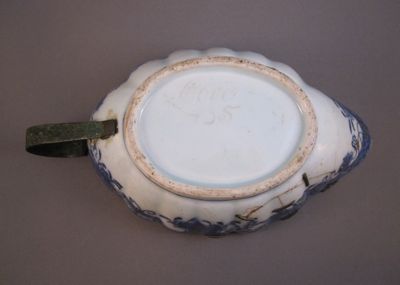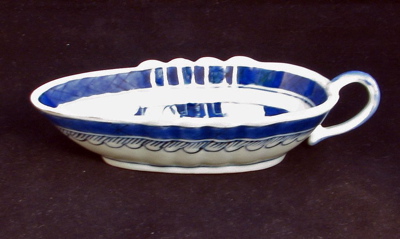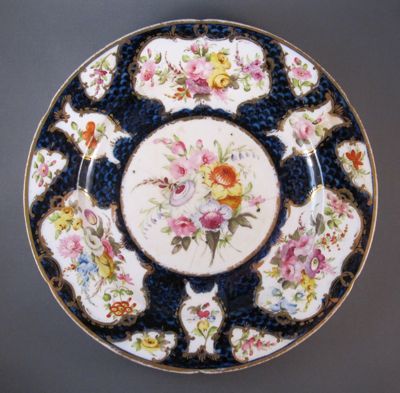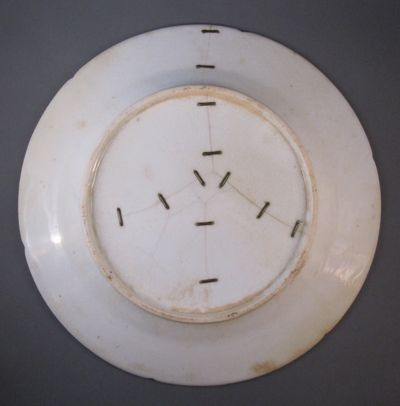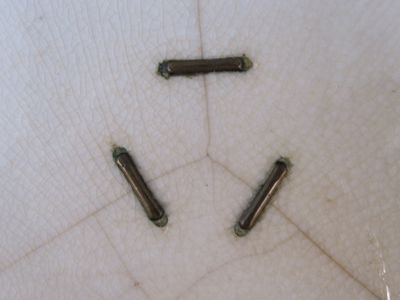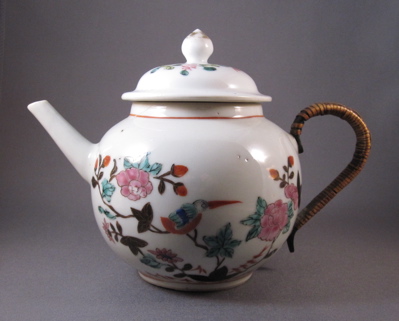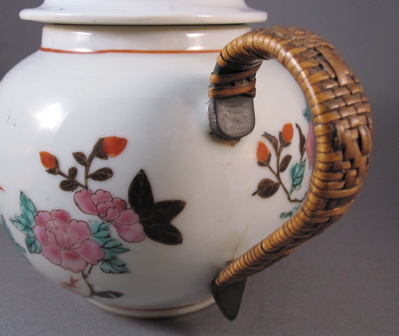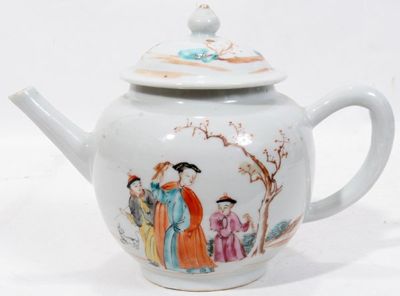I am a sucker for a double “make-do” and this one delivers a one-two punch! This thick-walled porcelain teapot was made in China during the Yongzheng period (1722-1735) and boasts an unusual square-paneled, bombe form. It is delicately decorated with a blue floral motif and measures 5″ high by 7″ wide from spout to handle. At some point in its early life it was regrettably dropped, breaking the spout and rendering it unusable. Luckily a silversmith was able to fashion a finely made replacement spout and once again the tea flowed. That is until many years later when the lid dropped. This time a tinsmith created a new metal replacement, incorporating a small turned-wood knob as a stand-in finial. The replacement lid is much cruder than the new spout and I believe about a century separates the two repairs. Although I pity the people who let the teapot and lid slip from their grasps, I am glad the owners had the good sense to remedy their unfortunate situations and repair both pieces in such an interesting fashion.
Posts Tagged ‘porcelain’
Derby porcelain ointment box, c.1905
Saturday, January 19th, 2013This tiny porcelain ointment box was made in England by Royal Crown Derby in the early 1900s. Standing a mere 1″ tall and with a diameter of 1-3/4″, it is one of the smallest antiques with inventive repairs I own. It is nicely hand decorated in the Imari pattern with classic cobalt blue, red and gilt enamels. The “V” mark on the bottom of both the lid and base dates this wee box to 1905. The underside of the lid reveals three metal staples, graduating in size from 1/4″ to 3/8″ long, which hold the two broken halves tightly together.
Clobbered Canton plate, c.1800
Sunday, December 9th, 2012This Chinese porcelain plate started out life in the early 1800s with traditional blue underglaze Canton decoration. It was later painted over or “clobbered” with overglaze washes of red, green enamels and gilt highlights, without much thought to the original plate’s decoration. As the demand for more colorful wares increased throughout Europe, enterprising merchants painted over their slow selling blue and white ceramics. Much of the over decorating was done in the Netherlands, where the pieces were referred to as “Amsterdams Bont” (colorful wares from Amsterdam) . Plate measures 8-3/4″ in diameter.
After the plate dropped and broke in to 4 pieces, it was made whole again by the addition of 9 metal staples.
A “Chinese” mark on the bottom is actually part of the Dutch clobbered decoration.
This Canton plate shows what mine looked like before it was embellished.
Photo courtesy of Antique Helper
Chinese-English “monster mug”, c.1780
Saturday, November 24th, 2012This is the story of a forced marriage between an 18th century Chinese porcelain mug and a 19th century English pottery jug, joined together by a mad tinker to live out the rest of their lives as one. The Qianlong period (1736-1795) mug with cobalt blue underglaze design stands 5-1/8″ high. The original handle, most likely in the form of a dragon, broke off sometime in the early 1800s. I imagine a clever repairer (or Dr. Frankenstein?) found a damaged English stoneware pottery jug, skillfully removed the intact snake-shaped handle and, using two metal rivets, reattached it to the body of a Chinese tankard…creating a hybrid Anglo-Asian monster mug!
This is what the original dragon handle on my Chinese mug would have looked like before it broke off. Photo courtesy of Ruby Lane
And this Mason’s Ironstone “Hydra” jug, made in Staffordshire, c.1830, shows the serpent handle intact. Photo courtesy of Selling Antiques
Miniature Davenport watering can, c.1860
Saturday, November 10th, 2012English porcelain miniature watering can made by Davenport in the mid-1800s. Finely painted with multicolor floral and scrollwork design with gilt accents. Measures 2-3/4″ high to tip of moth form lid finial and is 3-1/2″ wide from end to end. Stamped in red with DAVENPORT in a banner with an anchor, dating it from 1850 to 1870. Three brass staples on the handle, with the aid of some sloppily applied glue, hold the three broken pieces back together again.
“Dragons in Compartments” cup & saucer, c.1800
Saturday, October 13th, 2012This fine, lightweight porcelain cup & saucer set was made in Dresden, Germany in the late 18th century. It is hand decorated with polychrome enamels and gold highlights in the wonderfully stylized “Dragons in Compartments” pattern, also known as the “Bengal Tiger”, “Kylin” or “Bishop Sumner” pattern . At one point in its early life, someone sipping an expresso was so scared by the fierce dragons depicted on the sides that it was dropped and broke into 3 pieces. Gathering the broken shards and somehow finding the strength to face the fierce fire breathing monsters again, the brave soul brought the broken cup to a tinker, who was able to restore it, using metal staples. The intact saucer measures 4-1/2″ in diameter and I would have much preferred if it too were repaired with staples!
This li’l dragon seems to be smoking a stogie, which is actually a metal staple keeping him in one piece.
There are 8 tiny staples on the outside and one on the inside, once overpainted to mask the repair.
Cup measures 2″ in diameter and stands 2″ high.
Isn’t this the cutest, non-threatening dragon you have ever seen? To me it looks more like a super-hero kitten sporting a purple cape with green fringe.
Both the cup and saucer are mark on the bottom in blue “Made at Dresden”.
Bloor Derby coffee can, c.1810
Saturday, August 18th, 2012Colorful porcelain coffee can exquisitely decorated in the French style, made between 1806 and 1825 in London by Derby at their Nottingham Road factory. The wishbone form handle was detached over 150 years ago and riveted, soon afterward, back onto the body by a skilled metalsmith. It is marked on the underside with a red crown, crossed batons a “D” and (pattern number) 770, all hand painted in red.
For another example of an inventive repair in the same porcelain pattern, see “Wounded survivor” teapot, c.1810
Now that I own two pieces from this stunning tea set, I am on the hunt to find the remaining pieces. But naturally, I will turn away from “perfect” examples and only rescue the ones with inventive repairs!
Worcester porcelain plate, c.1770
Saturday, August 11th, 2012Porcelain plate made in England by Worcester in the late 1700s is brightly decorated with cartouches containing colorful floral sprays surrounded by gilt scrollwork and a scale background of mottled cobalt blue.
Unsigned plate measures 9-1/2″ in diameter.
Although most items I have seen repaired with metal staples are holding multiple pieces back together, this plate has bronze staples stabilizing cracks against further damage. I like how the symmetrical pattern of the cracks and the staples form an almost perfect peace sign.




